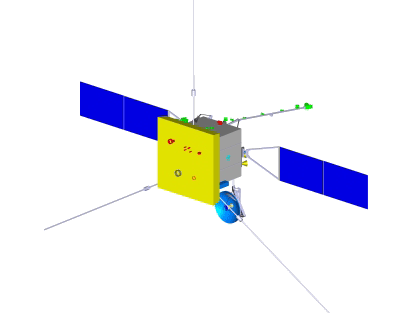- to determine in-situ, the properties and dynamics of plasma (a gas of charged particles), magnetic fields and particles in the near-Sun heliosphere,
- to survey the fine detail of the Sun's magnetised atmosphere,
- to identify the links between activity on the Sun's surface and the resulting evolution of the corona and inner heliosphere,
- observe and characterise the Sun's polar regions and equatorial corona from high latitudes.
About Project
 Name Solar Orbiter describes exactly what the spacecraft will do - it will orbit the Sun, passing closer than any space probe to date. It is ESA’s mission which will perform a close-up study of our Sun and inner heliosphere - the uncharted innermost regions of our Solar System- to better understand, and even predict, the unruly behaviour of the star on which our lives depend. At its closest point, the spacecraft will be closer to the Sun than any previous spacecraft, braving the fierce heat and will carry its telescopes to almost one-quarter of Earth's distance from our nearest star. It will provide unique data and imagery of the Sun.
Name Solar Orbiter describes exactly what the spacecraft will do - it will orbit the Sun, passing closer than any space probe to date. It is ESA’s mission which will perform a close-up study of our Sun and inner heliosphere - the uncharted innermost regions of our Solar System- to better understand, and even predict, the unruly behaviour of the star on which our lives depend. At its closest point, the spacecraft will be closer to the Sun than any previous spacecraft, braving the fierce heat and will carry its telescopes to almost one-quarter of Earth's distance from our nearest star. It will provide unique data and imagery of the Sun.
Solar Orbiter will be the first satellite to provide close-up views of the Sun's polar regions, which are very difficult to see from Earth, providing images from latitudes higher than 25 degrees. It will be able to almost match the Sun’s rotation around its axis for several days, and so it will be able for the first time to see solar storms building up over an extended period from the same viewpoint. It will also deliver data of the side of the Sun not visible from Earth.
Scientific instruments
SOLAR ORBITER carries a few highly sophisticated, lightweight instruments, weighing a total of 180 kg. One suite (the in-situ instruments) consists of detectors for observing particles and events in the immediate vicinity of the spacecraft. These include the charged particles and magnetic fields of the solar wind, radio and magnetic waves in the solar wind, and energetic charged particles:
- EPD: Energetic Particle Detector,
- Mag: Magnetometer,
- RPW: Radio and Plasma Waves,
- SWA: Solar Wind Plasma Analyser.

- EUI: Extreme Ultraviolet Imager,
- METIS: Coronagraph,
- PHI: Polarimetric and Helioseismic Imager,
- SoloHI: Heliospheric Imager,
- SPICE: Spectral Imaging of the Coronal Environment,
- STIX: X-ray Spectrometer/Telescope.
Launch in 2020
Solar Orbiter after its launch on an Atlas V 411 from Cape Canaveral, Florida on 10 February 2020 has begun its journey to the Sun. This will require a cruise phase lasting approximately 3 years. During this time, the instruments will be commissioned, and some in-situ data will be acquired. During the cruise, Solar Orbiter will use gravity assists from Venus and the Earth. These swing-bys will put Solar Orbiter into a 168-day-long orbit around the Sun from which the spacecraft will begin its scientific mission. Along this orbit, the spacecraft will reach closest approach to the Sun every five months, at around 60 solar radii, or 0.28 AU. It is foreseen minimum 3 years routine science operations.
During the course of the mission, additional Venus gravity assist manoeuvres will be used to increase the inclination of Solar Orbiter’s orbit, helping the instruments see the polar regions of the Sun clearly, for the first time. Solar Orbiter will eventually view the poles from an angle higher than 30 degrees, compared to 7 degrees at best from Earth.
Solar Orbiter exploits new technologies being developed by ESA for the BepiColombo mission to Mercury. These include heat-proofing for all the equipment and instruments, the solar power generator and the communications system. Solar Orbiter is specially designed to always point to the Sun, and so, its Sun-facing side is protected by a sunshield. The spacecraft will also be kept cool by the positioning of special radiators, which dissipate excess heat into space. The solar arrays and the communications system are inherited from the design of ESA’s BepiColombo mission to Mercury.
The mission is controlled from the European Space Operations Centre (ESOC), Darmstadt, Germany, using ESA’s Malargüe ground-station. The Science Operations will be managed from the European Space Astronomy Centre (ESAC), Madrid, Spain. Mission is nominally planned for 7 years of operation (including cruise phase) with the extension for the next 3 years.